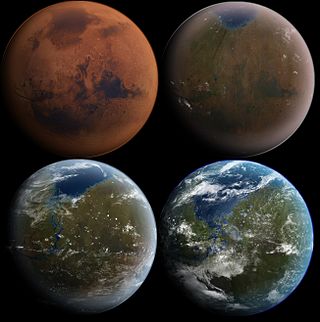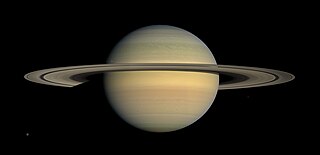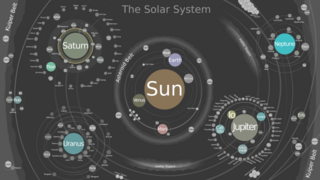
A comet is an icy, small Solar System body that warms and begins to release gases when passing close to the Sun, a process called outgassing. This produces an extended, gravitationally unbound atmosphere or coma surrounding the nucleus, and sometimes a tail of gas and dust gas blown out from the coma. These phenomena are due to the effects of solar radiation and the outstreaming solar wind plasma acting upon the nucleus of the comet. Comet nuclei range from a few hundred meters to tens of kilometers across and are composed of loose collections of ice, dust, and small rocky particles. The coma may be up to 15 times Earth's diameter, while the tail may stretch beyond one astronomical unit. If sufficiently close and bright, a comet may be seen from Earth without the aid of a telescope and can subtend an arc of up to 30° across the sky. Comets have been observed and recorded since ancient times by many cultures and religions.

The Solar System is the gravitationally bound system of the Sun and the objects that orbit it. The largest of these objects are the eight planets, which in order from the Sun are four terrestrial planets ; two gas giants ; and two ice giants. The Solar System developed 4.6 billion years ago when a dense region of a molecular cloud collapsed, forming the Sun and a protoplanetary disc.

Terraforming or terraformation ("Earth-shaping") is the hypothetical process of deliberately modifying the atmosphere, temperature, surface topography or ecology of a planet, moon, or other body to be similar to the environment of Earth to make it habitable for humans to live on.

Saturn is the sixth planet from the Sun and the second-largest in the Solar System, after Jupiter. It is a gas giant with an average radius of about nine-and-a-half times that of Earth. It has only one-eighth the average density of Earth, but is over 95 times more massive. Even though Saturn is nearly the size of Jupiter, Saturn has less than one-third of Jupiter's mass. Saturn orbits the Sun at a distance of 9.59 AU (1,434 million km) with an orbital period of 29.45 years.
Zecharia Sitchin was an author of a number of books proposing an explanation for human origins involving ancient astronauts. Sitchin attributed the creation of the ancient Sumerian culture to the Anunnaki, which he stated was a race of extraterrestrials from a planet beyond Neptune called Nibiru. He asserted that Sumerian mythology suggests that this hypothetical planet of Nibiru is in an elongated, 3,600-year-long elliptical orbit around the Sun. Sitchin's books have sold millions of copies worldwide and have been translated into more than 25 languages.

In geology, catastrophism is the theory that the Earth has largely been shaped by sudden, short-lived, violent events, possibly worldwide in scope. This contrasts with uniformitarianism, according to which slow incremental changes, such as erosion, brought about all the Earth's geological features. The proponents of uniformitarianism held that the present was "the key to the past", and that all geological processes throughout the past resembled those that can be observed today. Since the 19th-century disputes between catastrophists and uniformitarians, a more inclusive and integrated view of geologic events has developed, in which the scientific consensus accepts that some catastrophic events occurred in the geologic past, but regards these as explicable as extreme examples of natural processes which can occur.

Immanuel Velikovsky was a Russian-American psychoanalyst, writer, and catastrophist. He is the author of several books offering pseudohistorical interpretations of ancient history, including the U.S. bestseller Worlds in Collision published in 1950. Velikovsky's work is frequently cited as a canonical example of pseudoscience and has been used as an example of the demarcation problem.
The cataclysmic pole shift hypothesis is a pseudo-scientific claim that there have been recent, geologically rapid shifts in the axis of rotation of Earth, causing calamities such as floods and tectonic events or relatively rapid climate changes.

The Nibiru cataclysm is a supposed disastrous encounter between Earth and a large planetary object that certain groups believed would take place in the early 21st century. Believers in this doomsday event usually refer to this object as Nibiru or Planet X. The idea was first put forward in 1995 by Nancy Lieder, founder of the website ZetaTalk. Lieder claims she is a contactee with the ability to receive messages from extraterrestrials from the Zeta Reticuli star system through an implant in her brain. She states that she was chosen to warn mankind that the object would sweep through the inner Solar System in May 2003 causing Earth to undergo a physical pole shift that would destroy most of humanity.

Broca's Brain: Reflections on the Romance of Science is a 1979 book by the astrophysicist Carl Sagan. Its chapters were originally articles published between 1974 and 1979 in various magazines, including The Atlantic Monthly, The New Republic, Physics Today, Playboy, and Scientific American. In the introduction, Sagan wrote:
As long as there have been human beings, we have posed the deep and fundamental questions. ... If we do not destroy ourselves, most of us will be around for the answers. ... By far the most exciting, satisfying and exhilarating time to be alive is the time in which we pass from ignorance to knowledge on these fundamental issues.

The terraforming of Venus or the terraformation of Venus is the hypothetical process of engineering the global environment of the planet Venus in order to make it suitable for human habitation. Adjustments to the existing environment of Venus to support human life would require at least three major changes to the planet's atmosphere:
- Reducing Venus's surface temperature of 737 K
- Eliminating most of the planet's dense 9.2 MPa (91 atm) carbon dioxide and sulfur dioxide atmosphere via removal or conversion to some other form
- The addition of breathable oxygen to the atmosphere.

Kronos: A Journal of Interdisciplinary Synthesis published articles on topics related to the theories of Immanuel Velikovsky, it was "founded, with no apologies, to deal with Velikovsky's work"; and as such hosted epigraphs on a wide range of subjects from ancient history, catastrophism and mythology. It ran 44 issues from the Spring of 1975 to the Spring of 1988. The title is an homage to the Greek name for the Roman god Saturn whose planetary namesake Velikovsky believed Earth once orbited as a satellite. Professor of Social Theory Alfred de Grazia at New York University, co-author of The Velikovsky Affair and avowed supporter of some of Velikovsky's maverick ideas, however, remarked that although the journal was devoted to discussing Velikovsky's ideas, "[t]his is not to say that the directors of Kronos were uncritical". The journal was published by Kronos Press, a division of Cosmos and Chronos. Its subscription list grew to about 2000 and then settled to about 1500 people from 10 countries.

Charles Leroy Ellenberger is perhaps best known as a one-time advocate, but now a critic of, controversial writer Immanuel Velikovsky and his works on catastrophism. He first read Worlds in Collision in 1969. In 1979, he became a contributing editor to the Velikovsky-inspired Kronos journal, and has contributed material to many other publications. In 1980 he was selected by the editor of Astronomy magazine to debate James Oberg on Velikovsky.

Pensée: Immanuel Velikovsky Reconsidered ("IVR") was a special series of ten issues of the magazine Pensée advancing the pseudoscientific theories of Immanuel Velikovsky. It was produced to "encourage continuing critical analysis of all questions raised by Velikovsky's work", published between May 1972 and Winter 1974-75 by the Student Academic Freedom Forum, whose president was David N. Talbott, with the assistance and cooperation of Lewis and Clark College, Portland, Oregon. Velikovsky -- "the man whose work was being examined 'objectively'" insinuated himself into the editing of the May 1972 issue, just as he had done earlier for the April 1967 "Velikovsky" issue of Yale Scientific Magazine.

Retrograde motion in astronomy is, in general, orbital or rotational motion of an object in the direction opposite the rotation of its primary, that is, the central object. It may also describe other motions such as precession or nutation of an object's rotational axis. Prograde or direct motion is more normal motion in the same direction as the primary rotates. However, "retrograde" and "prograde" can also refer to an object other than the primary if so described. The direction of rotation is determined by an inertial frame of reference, such as distant fixed stars.

David Morrison is an American astronomer, a senior scientist at the Solar System Exploration Research Virtual Institute, at NASA Ames Research Center in Mountain View, California. Morrison is the former director of the Carl Sagan Center for Study of Life in the Universe at the SETI Institute and of the NASA Lunar Science Institute. He is the past Director of Space at NASA Ames. Morrison is credited as a founder of the multi-disciplinary field of astrobiology. Morrison is best known for his work in risk assessment of near Earth objects such as asteroids and comets. Asteroid 2410 Morrison was named in his honor. Morrison is also known for his "Ask an Astrobiologist" series on NASA's website where he provides answers to questions submitted by the public. He has published 12 books and over 150 papers primarily on planetary science, astrobiology and near Earth objects.

In astrology, planets have a meaning different from the astronomical understanding of what a planet is. Before the age of telescopes, the night sky was thought to consist of two similar components: fixed stars, which remained motionless in relation to each other, and moving objects/"wandering stars", which moved relative to the fixed stars over the course of the year(s).

The following outline is provided as an overview of and topical guide to the Solar System:

Comets have been observed by humanity for thousands of years, but only in the past few centuries have they been studied as astronomical phenomena. Before modern times, great comets caused worldwide fear, considered bad omens foreboding disaster and turmoil, for example the 1066 passage of Halley's Comet depicted as heralding the Norman conquest of England. As the science of astronomy developed planetary theories, understanding the nature and composition of comets became a challenging mystery and a large area of study.
Michael Wulf Friedlander was a South African-born American physicist and skeptic. Friedlander was professor emeritus of physics at Washington University in St. Louis. His research involved the study of cosmic rays and gamma ray astronomy. He is the author of the book At The Fringes Of Science (1998), a scholarly study of fringe science. The book is notable for its criticism of the ideas of Immanuel Velikovsky.

















